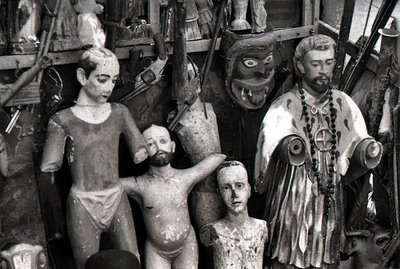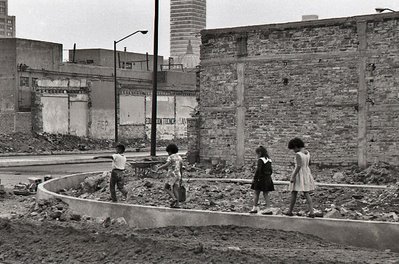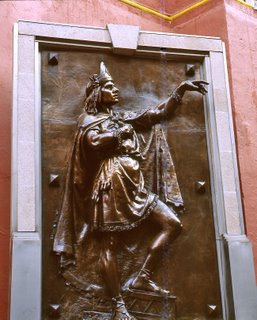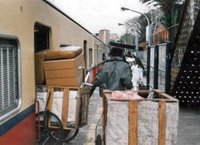A Fasting Coyote - Mike Harcourt & Homelessness In Vancouver
Wednesday, January 16, 2008
Homelessness can be solved by building homes for them.
Mike Harcourt - 2007
There is nothing more self-evident than that which is self-evident.
Willoughby Blew - 1994

When Rebecca and Abraham Rogatnick and I go to the baroque concerts on select Friday evenings at St James Anglican on Cordova Rebecca invariably asks me to drive by Main and Hastings. "I want to see all those drug and homeless people," she tells me.
I was 9 when I first got a glimpse that there was something not quite right with my world. My father had taken me to downtown Buenos Aires to see a documentary (in living colour) of the Jívaro Indian headshrinkers. As we left I was feeling mixed emotions after seeing those miniature heads with their sewn up eyes and mouth. There was a woman outside holding a baby and she had one hand out. "Who is she?" I asked my father. His answer, "She is a Bolivian beggar," was much too complicated for me to comprehend. At the time and even now many Argentines believe there is no poverty in their country and only Chileans, Bolivians, Paraguayans and Peruvians who drift to Argentina are poor. By 1954 I knew a bit better and I heard my mother telling my grandmother how Perón had built high walls to cover the sight of shanty towns when important dignitaries came to town. The walls were then painted with slogans about a Plan Quinquenal, a Stalin type five-year plan, or such sayings as "En la Argentina los únicos privilegiados son los niños", in Argentina only the children are deserving of privilege.

Thus I never really got to see Argentine shanty towns or villas miseria as they are called. By 1955 we were in Mexico City and poverty and beggars were much more evident. I observed pepenadores which is a Náhuatl word for scavenger. These people pushing makeshift wooden carts picked up cardboard and whatever other potentially valuable stuff they could find. This was taken to huge mountains of rubbish in the outskirts of Mexico City where it was distributed into piles and eventually sold to early Mexico City recyclers. The pepenadores and their families lived in and around these dumps.
A couple of years ago retired Provincial NDP cabinet minister Bob Williams went to Buenos Aires to investigate how people live in the huge villa miserias of the city. One of the biggest, Villa 31 is located between tracks of the central train station of Retiro. Williams came up with a solution that would greatly increase the income earning capacity of those who live in the villa miserias, many of them being cartoneros who collect carboard. He told me that small and efficient garbage compacters would make it easier for residents to recycle.

On the northeast corner of Mexico City on what was once lake Texcoco, in the early 60s there was only a dry lake bed of what had been a lake during the time of the Spanish conquest. After years of draining it to satisfy the thirst of the growing Mexico City metropolis it was now a waste land. Squatters moved in little by little and in 1963 the growng shanty town was officially designated as the municipality of Ciudad Nezahualcoyótl named after a poet king of the 1400s whose name in Chichimeca means Fasting Coyote. I would think that this would be a most appropriate name for people whose drive to feed themselves every day was no different and no less bleak than an Innuit attempting to survive a winter in the 19th century.
By the time Rosemary and our family moved to Vancouver in 1975 Ciudad Nezahualcóyotl already had a population of one million. In the dry winter, winds from the north would blow past the shanty town lifting fecal matter that the rich in the southern parts of the city would breathe. It was then that respiratory diseases became endemic in the area. Today Ciudad Nezahualcoyótl's population exceeds 4 million. In the early 70s Rosemary and I taught English to the personnel of the Westin hotel Camino Real. We taught the room service, housekeeping staff on how to deal with their interaction with American guests. We taught them to reply to such things as, "I have no hot water," Can I please have a grapefruit and some apples and pears?" We soon found out that many of our students, some who rode in rickety buses for two to three hours to get to the hotel lived in Ciudad Nezahualcoyótl. Most had never seen a pear, an apple or a grapefruit. Rosemary and I started to bring fruit to the class to show them what a mysterious grapefruit looked like.
Argentines have villa miserias and the Brazilians their favelas. Most countries have them and find euphemisms to soften the stigma. In the 1980s my wife used to make business trips to Los Angeles. I remember her calling me up one evening and telling me that there were people outside the hotel living in cardboard boxes. It sounded surreal, almost as surreal as the Tren Blanco.

The Tren Blanco (white train) would leave the Buenos Aires station of José León Suárez around 5 pm. People boarded the train with empty pushcarts. Like a rápido, the train would then speed to the downtown central station of Retiro without stopping. I saw it many times in the late 90s. In Retiro the people and their pushcarts would then go and pick up cardboard and stuff left outside buildings in the business district of the city. They would then return around midnight when the Tren Blanco would take them back to José León Suárez for the eventual re-distribution and recycling of the stuff. It amazes me that the railroad company (now privately run) would charge these Argentine cirujas (the Argentine term for a Mexican pepenador) for the use of the train. Waiting for a train at the station of La Lucila (coming back from visiting a relative there) I remember in 2004seeing the white train pass by with its cargo of cirujas and stuff. It was a ghost train and to many who live in Buenos Aires the story of the train is an urban myth. From the high vantage point of my brother's apartment that overlooks the Retiro railyard I was was able to see in 2004 the vast and sprawling Villa 31. It is no myth.
I have been giving all the above some thought as I try to grapple with Rebecca's obsession with passing by Main and Hastings. Except for an occasional makeshift structure under the Granville Street Bridge I am not sure that Vancouver has a shanty town. Unlike other cities of the world is Vancouver truly not only a nuclear weapons but also a shanty town free zone?
What would happen if the Finning Tractor land were razed and fiberglass or corrugated metal roofing were piled in one corner with scrap wood and other building stuff? Would the homeless come and build? Would a shanty town solve our homelessness? It would be easy enough to build high Perón style walls around it to hide the potential eyesore from Olympic visitors. Would Vancouver, at last, boasting a real shanty town, be finally that world-class city it strives to be?
Architect Abraham Rogatnick has explained to me that Federal and Provincial building codes stipulate how small a bedroom can be. A homeless person wants a room with a bathroom. A prison cell is surely a room with a bathroom. And surely the Federal laws that regulate the "humane" dimensions of a prison cell could be ammended so that rapid, prefabricated housing could be built in Vancouver and prove that Mike Harcourt's solution isn't all that untenable. Is it self-evident?






